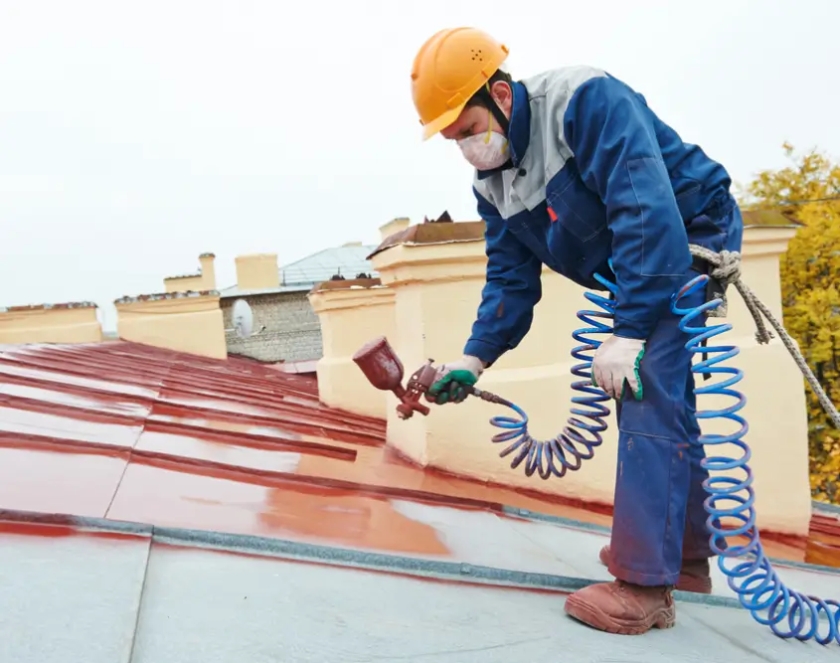Painting your roof can enhance your home’s aesthetic appeal and provide crucial protection against the elements. However, achieving a professional-looking result requires careful planning and execution. Whether you’re painting an asphalt, wood, or metal roof, following the proper techniques and using the appropriate materials is essential. Here are some expert tips and tricks to ensure your roof painting project succeeds.
- Choose the Right Paint Type
Before embarking on your roof painting journey, it’s vital to select the correct type of paint for the material of your roof. Asphalt, wood, and metal roofs require specific paints for optimal adhesion and durability. For example, acrylic paints are suitable for asphalt roofs due to their flexibility and resistance to UV rays. At the same time, epoxy or polyurethane coatings are ideal for metal roofs for their corrosion resistance.
- Consider the Coating
Apart from the paint type, the coating you choose plays a significant role in determining the longevity and performance of your roof paint. Options such as acrylic, silicone, asphalt, and polyurethane coatings offer different benefits in terms of waterproofing, UV resistance, and durability. Evaluate your climate and environmental factors to select the most suitable coating for your roof.
- Inspect for Damages
Before beginning the painting process, thoroughly inspect your roof for damages such as cracks, leaks, or rust spots. Addressing these issues beforehand ensures that your paint job will look better and provide adequate protection to your roof structure. Repair any damage using appropriate materials and techniques before proceeding with painting.
- Prepare and Clean the Surface
Proper preparation is key to achieving a flawless finish and ensuring paint adherence. Clean the roof surface to remove dirt, debris, and existing coatings. Pressure washing is an effective method to eliminate stubborn stains and contaminants. Additionally, consider applying a primer to improve paint adhesion and promote a uniform finish, especially on porous surfaces like wood.
- Plan Around the Weather
Timing your roof painting project is crucial, and planning around the weather forecast is essential. Avoid painting during rainy or excessively humid conditions, as it can affect the drying and curing process of the paint. Ideally, choose a period of mild weather with moderate temperatures and low humidity to ensure optimal conditions for painting and drying.
- Use the Right Painting Method
Selecting the appropriate painting method is essential for achieving the desired results efficiently. Depending on the size and texture of your roof, you can opt for spray, roller, or brush painting techniques. Spraying is often preferred for more extensive, smoother surfaces, providing quick and even coverage. Rollers are suitable for medium-sized roofs and offer good coverage with minimal effort. Brushes are best for precision work and smaller areas, ensuring neat edges and detail.
- Apply Multiple Thin Coats
Rather than applying a single thick coat of paint, consider using multiple thin coats for better coverage and durability. Thin coats allow the paint to adhere more effectively to the surface, preventing dripping or uneven coverage. Additionally, applying multiple coats ensures thorough protection against UV rays, weathering, and other environmental factors, extending the lifespan of your roof paint.
- Use High-Quality Tools and Equipment
Investing in high-quality painting tools and equipment can significantly improve the outcome of your roof painting project. Opt for durable brushes, rollers, and sprayers designed for exterior painting tasks. Quality tools make the application process smoother and more efficient and contribute to a more professional-looking finish. Additionally, using the right equipment minimizes the risk of accidents and ensures safety throughout the project.
- Apply a Protective Sealant
After completing the painting process, consider applying a protective sealant to enhance the longevity and performance of your roof paint. Sealants provide an additional layer of protection against moisture, UV rays, and other environmental hazards, helping to maintain the integrity of the paint job over time. Choose a sealant compatible with your paint type and coating for optimal results. Regularly inspect and reapply the sealant to keep your roof looking fresh and well-protected.
You may also like to read about – What You Need to Know About Painting Your Home’s Exterior
Final Thoughts:
By following these expert tips and tricks, you can confidently tackle your roof painting project and achieve professional-grade results. Remember to prepare properly, choose high-quality materials, and adhere to best practices. A well-painted roof not only enhances your home’s curb appeal but also provides long-lasting protection against the elements, ensuring the integrity and longevity of your roof for years to come.
